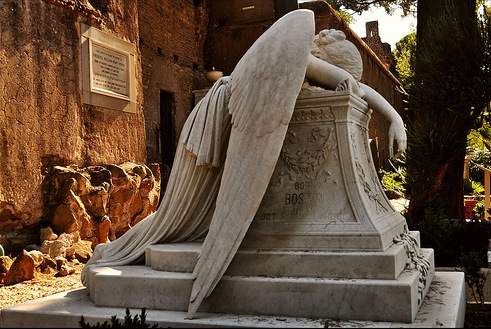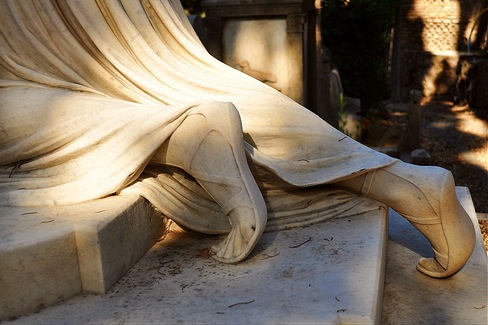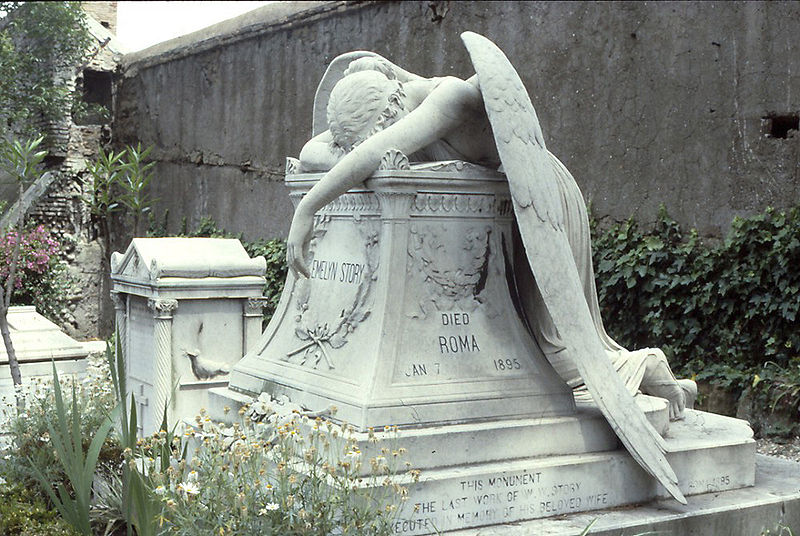In cemeteries across the world, “Angel of Grief” is a recurring, statuary subject based upon a prototype by William Wetmore Story from 1894. Donning classical Roman costume, the angel is portrayed slumping over a headstone as a lugubrious testament to bereavement. Eternally suspended in despair, her drooping wings and buckled posture vividly express the figure’s mournful tone, where folded arms obscure the statue’s face. This familiar archetype appears across both our cultural and literal landscape; there are six replications in California, eight in Texas, four in New York and others in countries such as Canada, the United Kingdom and Costa Rica. One of the most notable examples of “Angel of Grief” is in the Arboretum of Stanford University. The sculpture was commissioned by Jane Stanford for her brother Henry Lathrop in 1901. Due to its prominence, the BBC television program Dr. Who even based several episodes on supernatural monsters that referenced these funereal Angels in the 3rd, 5th, 6th and 7th seasons.

Story’s “Angel of Grief.” Image by Livia B.
While this statue is based on ancient Roman imagery, the heavy lassitude of her posture is far more modern. William Story was one of the most prominent neoclassical sculptors in America, though he expatriated to Rome. Among some of his most famous works are the Semiramis in the Dallas Museum of Art, based on the ancient queen of Babylon, and Cleopatra in the Metropolitan Museum of Art. His corpus is renowned for its psychologically brooding depictions of female figures.
William Story moved to Rome in 1850 after abandoning his career as a lawyer to pursue sculpting full time. He resided in the illustrious Palazzo Barberini, shared by a contingent of American intellectuals. Having lived a fruitful and active life in Rome for many years, Story’s wife Emelyn died at the age of 74 in 1895. While in the throes of a deep despair, the sculptor’s children encouraged their father to produce a work to memorialize his lost partner. Describing Emelyn as “My life, my joy, my stay and help in all things,” William Story carved his last statue before dying the following year. He and Emelyn were buried together in the Cimetero Acattolico (translated as the Non-Catholic Cemetery) in the city.
“Eternally suspended in despair, her drooping wings and buckled posture vividly express the figure’s mournful tone”
In 1896, Cosmopolitan Magazine wrote that “The loss of the wife of his youth whom he survived but a year was a bitter blow [and] with her passed his interest in affairs. It was only when his children suggested that he should make a monument to her memory that he consented to resume work; the design he chose was the “Angel of Grief” and it is wrought to exquisite finish, as are the statues modeled in his summer prime. When this was done he left the studio never to return.” Since then, “Angel of Grief” has served as a poignant symbol for the collective reverberations of mourning across cemeteries around the world.

Story’s “Angel of Grief.” Image by Livia B.
Related Articles:
- On Grief and Grieving: Caring for Yourself When Someone You Cared for Dies (amnottheonlyone.com)
- Coping With Grief: How to Handle Your Emotions (everydayhealth.com)
- – Life lessons from end-of-life industry experts, medical professionals and those grieving loss (sevenponds.com)

 The Sculpture “Angel of Grief”
The Sculpture “Angel of Grief”



 “Hand to Earth” by Andy Goldsworthy
“Hand to Earth” by Andy Goldsworthy
 Trans Remembrance Project Provides a Community of Grieving
Trans Remembrance Project Provides a Community of Grieving
 Caring for a Dying Loved One? Be Gentle With Yourself.
Caring for a Dying Loved One? Be Gentle With Yourself.














